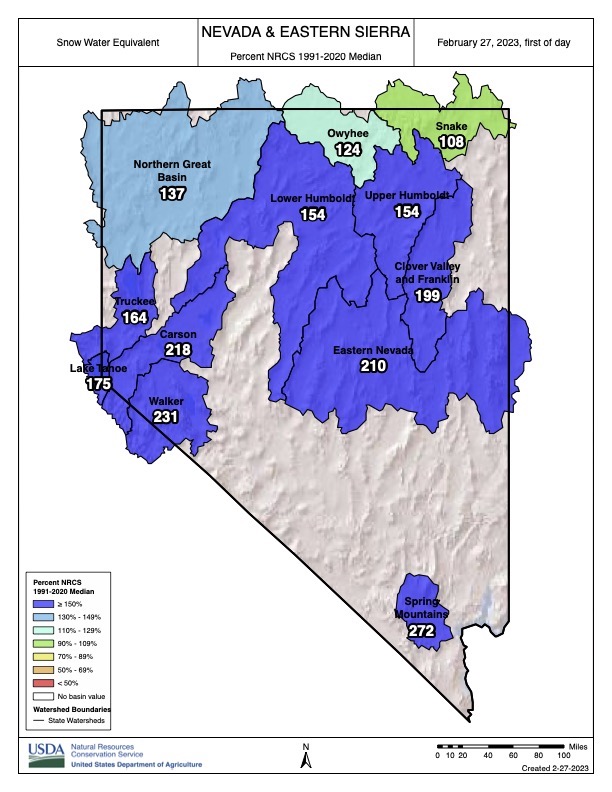Graph showing snow water equivalent level for Carson River Basin, which, as of Feb. 27, was 40.6 inches.
NRCS Nevada
A larger-than-average snowpack in the mountains above Carson City is holding steady as snowstorms continue toward spring, and the snow is bringing benefits for drought-stricken western Nevada and challenges for city departments.
“We have lots of storms in the forecast,” Jeff Anderson, hydrologist for the USDA Natural Resources Conservation Service, Nevada, said Monday. “Drought conditions have shown a lot of improvement. The reservoir storage is going to improve greatly once it starts to melt.”
Anderson said the Carson Range has moved up two categories in the U.S. Drought Monitor. The water year began Oct. 1 when the region was in the severe drought category, and now the mountains around Lake Tahoe are no longer listed in drought but still “abnormally dry” as the wet winter makes up a huge water deficit from the preceding three years.
As of Feb. 27, 11 sites in the Lake Tahoe Basin were showing snow water equivalent of 39.9 inches, which puts the total snowpack at 175 percent of median for the date.
 Snowpack map showing percent of median for various basins in Nevada and the Eastern Sierra. (NRCS Nevada)
Snowpack map showing percent of median for various basins in Nevada and the Eastern Sierra. (NRCS Nevada) According to the National Weather Service, snow water equivalent is the “depth of water that would cover the ground if the snow cover was in a liquid state.”
Further south along the Sierra, the snowpack is even thicker. The Carson River Basin, with 12 sites, was at 218 percent of median for the date, totaling 40.6 inches of snow water equivalent.
Seven sites in the Walker River Basin produced a reading of 42.8 inches of snow water equivalent, or 231 percent of median for the date.
“They’re talking about another storm next weekend and considering where we are right now and the forecast, the Walker (River Basin) has a chance to get the biggest winter on record,” said Anderson.
Anderson said reservoirs like Lahontan could fill up this summer with the run-off.
“It’s a pretty big volume of water,” he said.
He said prolonged high flows throughout summer are possible because “there is a lot of snow to melt.”
That plentitude of water poses some challenges.
“Our number one concern will be we don’t want it to all melt at once, or there will be flooding,” said Carson City Public Works Director Darren Schulz
Schulz urged residents to keep storm drains clear heading into warmer months.
“For residents and businesses in Carson City, as soon as the storm drain drop inlets are visible make sure they are clean and clear so melting snow can find its way into the storm drain system,” he said. “If you see a problem, report it to Public Works.”
Residents can call 775-887-2355 with problems.
Carson City Fire Chief Sean Slamon sees both good and bad in the wet winter.
“We are certainly thankful for our very wet winter this year,” he said. “We needed it. It will help reduce impacts of previous drought.”
However, Slamon is concerned how spring and summer will play out with “more robust and taller grasses.” He said cheat grass and other small fuels can spread fire quickly.
“Depending on how warm the spring is we could have a slower start to the fire season,” he said. “Our concern is definitely the later part of summer as fuels and grasses dry out.”
Also worried about a quick warm-up and flooding, Slamon hopes for a “slow, mild spring.”
As the NWS forecast a 45 percent chance of snow for the upcoming weekend, travel hazards will remain a concern.
“Traffic accidents go up when it snows,” said Sheriff Ken Furlong, “but by and large, people are doing well.”
Furlong pointed to a multiple-car wreck in Washoe Valley on Feb. 26 that closed I-580 in both directions.
“It’s isolated cases of people extending their vehicles beyond their capabilities,” he said. “One person not paying attention to weather conditions can cause a lot of damage to other people. We all have to slow down.”
To check local road conditions, visit https://www.nvroads.com/.